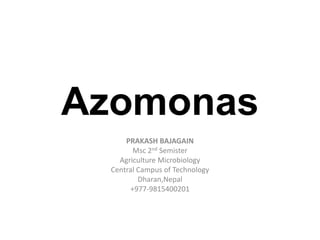
Azomonas
- 1. Azomonas PRAKASH BAJAGAIN Msc 2nd Semister Agriculture Microbiology Central Campus of Technology Dharan,Nepal +977-9815400201
- 2. Non-symbiotic nitrogen-fixing bacteria • Some important non-symbiotic nitrogen-fixing bacteria include :- • Achromobacter, Acetobacter, Alcaligenes, Arthrobacter, Azosp irillum, Azotobacter, Azomonas, Bacillus, Beijerinckia, Clostridi um, Corynebacterium, Derxia, Enterobacter, Herbaspirillum, Kl ebsiella, Pseudomonas, Rhodospirillum, Rhodopseudomonas and Xanthobacter • They colonize in rhizosphere and derived their energy by oxidation of soil organic matter and fix atmospheric nitrogen into the soil and subsequently increase the soil fertility.
- 3. Azotobacteriaceae • Azotobacteriaceae comprises two genera:- Non-cyst forming bacterial group:- Azomonas with three species (A. agilis, A. insignis and A. macrocytogenes) • and cyst-forming:- Azotobacter comprising of 6 species namely, A. chroococcum, A. vinelandii, A. beijerinckii, A. nigricans, A. armeniacus and A. paspali • Beijerinckia and Derxia are not closely related to the genera Azotobacter and Azomonas, but that they belong to other subdivisions or groups, i.e., the alpha and the beta subclasses, respectively of the Proteobacteria.
- 4. Classification Scientific classification Kingdom:Bacteria Phylum:Proteobacteria Class:Gammaproteobacteria Order:Pseudomonadales Family:Pseudomonadaceae/Azotobacteraceae (unranked):Azotobacter group Genus:Azomonas Winogradsky, 1938 Species Azomonas agilis Azomonas insignis Azomonas macrocytogenes
- 5. Azomonas • Azomonas species are typically motile, oval to spherical, and secrete large quantities of capsular slime. They are distinguished from Azotobacter by their inability to form cysts, but like Azotobacter, they can biologically fix nitrogen under aerobic conditions (diazotrophs). • Bacteria of the genus Azomonas are known to form intracellular inclusions of polyhydroxyalkanoates under certain environmental conditions (e.g. lack of elements such as phosphorus, nitrogen, or oxygen combined with an excessive supply of carbon sources).
- 7. Species • Azomonas agilis (Beijerinck 1901) Winogradsky 1938 • Azomonas insignis (Derx 1951) Jensen 1955, species. • Azomonas macrocytogenes (Jensen 1955) New and Tchan 1982
- 8. Azomonas agilis • Azomonas agilis, a nitrogen-fixing bacterium, was isolated from rhizospheric soil in central Myanmar. • Azomonas agilis is a species of motile, Gram-negative bacteria found in water and is capable of fixing atmospheric nitrogen. It is the type strain for the genus Azomonas. • A. agilis resembles protists with its ovoid, ellipsoidal, or coccoid cells. The cells are relatively large, usually 2.5-6.4 μm long and 2.0-2.8 μm wide, though giant cells that are 10.0-13.5 μm have been described. • The cells have peritrichous flagella which enable motility.The species also produces a diffusible yellow-green or red-violet pigment which fluoresces bluish-white under ultraviolet light. • A. agilis was first isolated and described by Martinus Beijerinck in 1901, who obtained the species from Dutch canal water in Delft. Beijernick's original strain has been lost, so the strain isolated by Albert Kluyver and van den Bout is now the neotype. Despite the fact that mannitol was used by Beijerinck in his enrichment medium for A. agilis, the bacteria in pure culture cannot use it as a carbon source unless it is first degraded by other microbes. • The species can tolerate salt concentrations up to 1.0% and is resistant to iodoacetate (1 μM) which suggests it may have ability to live in contaminated waters with relatively high concentrations of organic matter and mineral salts.This bacterium has also been implicated in the bioremediation of cadmium-polluted water.
- 10. Azomonas macrocytogenes • The name Azomonas macrocytogenes (Jensen 1955) Baillie, Hodgkiss, and Norris 1962, 118 does not appear in the Approved Lists of Bacterial Names, although it was accepted in the 8th edition of Bergey’s Manual and was included in the first draft of the Approved Lists . • This aerobic, nonsymbiotic, nitrogen-fixing organism was originally included by Jensen in the microcyst-forming genus Azotobacter, although the author was not certain whether cysts are actually formed. • Baillie et al. assigned the organism to the genus Azomonas on the basis of polar flagellation and lack of cyst formation. However, Thompson and Skerman have reported cyst formation by four of seven strains. • Azomonas rnacrocytogenes and Azomonas insignis are more similar to each other than to the third member of the genus, Azomonas agilis, in terms of flagellation and deoxyribonucleic acid base composition
- 11. Biofertilizer • The commercial history of biofertilizers began by Nobbe and Hiltner, a laboratory culture of Rhizobia in 1895, followed by the discovery of Azotobacter and then the blue green algae and a host of other microorganisms.
- 12. Thank You